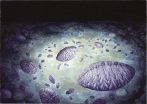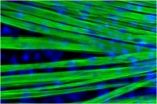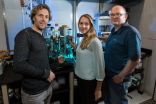(Press-News.org) Researchers led by the University of Cambridge have found the earliest example of reproduction in a complex organism. Their new study has found that some organisms known as rangeomorphs, which lived 565 million years ago, reproduced by taking a joint approach: they first sent out an 'advance party' to settle in a new area, followed by rapid colonisation of the new neighbourhood. The results, reported today in the journal Nature, could aid in revealing the origins of our modern marine environment.
Using statistical techniques to assess the distribution of populations of a type of rangeomorph called Fractofusus, the researchers observed that larger 'grandparent' rangeomorphs were randomly distributed in their environment, and were surrounded by distinct patterns of smaller 'parents' and 'children'. These patterns strongly resemble the biological clustering observed in modern plants, and suggest a dual mode of reproduction: the 'grandparents' being the product of ejected waterborne propagules, while the 'parents' and 'children' grew from 'runners' sent out by the older generation, like strawberry plants.
Rangeomorphs were some of the earliest complex organisms on Earth, and have been considered to be some of the first animals - although it's difficult for scientists to be entirely sure. They thrived in the oceans during the late Ediacaran period, between 580 and 541 million years ago, and could reach up to two metres in length, although most were around ten centimetres. Looking like trees or ferns, they did not appear to have mouths, organs, or means of moving, and probably absorbed nutrients from the water around them.
Like many of the life forms during the Ediacaran, rangeomorphs mysteriously disappeared at the start of the Cambrian period, which began about 540 million years ago, so it has been difficult to link rangeomorphs to any modern organisms, or to figure out how they lived, what they ate and how they reproduced.
"Rangeomorphs don't look like anything else in the fossil record, which is why they're such a mystery," said Dr Emily Mitchell, a postdoctoral researcher in Cambridge's Department of Earth Sciences, and the paper's lead author. "But we've developed a whole new way of looking at them, which has helped us understand them a lot better - most interestingly, how they reproduced."
Mitchell and her colleagues used high-resolution GPS, spatial statistics and modelling to examine fossils of Fractofusus, in order to determine how they reproduced. The fossils are from south-eastern Newfoundland in Canada, which is one of the world's richest sources of fossils from the Ediacaran period. Since rangeomorphs were immobile, it is possible to find entire ecosystems preserved exactly where they lived, making them extremely suitable for study via spatial techniques.
The 'generational' clustering patterns the researchers observed fit closely to a model known as a nested double Thomas cluster model, of the type seen in modern plants. These patterns suggest rapid, asexual reproduction through the use of stolons or runners. At the same time, the random distribution of larger 'grandparent' Fractofusus specimens suggests that they were the result of waterborne propagules, which could have been either sexual or asexual in nature.
"Reproduction in this way made rangeomorphs highly successful, since they could both colonise new areas and rapidly spread once they got there," said Mitchell. "The capacity of these organisms to switch between two distinct modes of reproduction shows just how sophisticated their underlying biology was, which is remarkable at a point in time when most other forms of life were incredibly simple."
The use of this type of spatial analysis to reconstruct Ediacaran organism biology is only in its infancy, and the researchers intend to extend their approach to further understand how these strange organisms interacted with each other and their environment.
INFORMATION:
The research was funded by the Natural Environment Research Council.
High-dose vitamin D supplementation in postmenopausal women was not associated with beneficial effects on bone mineral density, muscle function, muscle mass or falls, according to the results of a randomized clinical trial published online by JAMA Internal Medicine.
Low levels of vitamin D contribute to osteoporosis because of decreased total fractional calcium absorption (TFCA) and nearly half of postmenopausal women sustain an osteoporotic fracture. However, experts disagree on the optimal vitamin D level for skeletal health. Some experts contend that optimal serum ...
A recently discovered family of small RNA molecules, some of which have been implicated in cancer progression, has just gotten much larger thanks to a new RNA sequencing technique developed by researchers at UC Santa Cruz.
The technique, described in a paper published August 3 in Nature Methods, provides sensitive detection of small RNAs that are chemically modified (methylated) after being transcribed from the genome. The researchers used the technique to reveal an abundance of modified fragments derived from transfer RNA molecules in both yeast cells and human cells.
"Transfer ...
Skeletal muscle is one of the most abundant tissue types in the human body, but has proven difficult to produce in large quantities in the lab. Unlike other cell types, such as heart cells, neurons and cells found in the gut, previous attempts to efficiently and accurately derive muscle cells from pre-cursor cells or culture have not been fruitful. In a new study published this week in Nature Biotechnology, investigators from Brigham and Women's Hospital (BWH) report that by identifying and mimicking important developmental cues, they have been able to drive cells to grow ...
LA JOLLA--T cells are the guardians of our bodies: they constantly search for harmful invaders and diseased cells, ready to swarm and kill off any threats. A better understanding of these watchful sentries could allow scientists to boost the immune response against evasive dangers (e.g., cancer or infections), or to silence it when it mistakenly attacks the body itself (e.g., autoimmune disorders or allergies).
Now, scientists at the Salk Institute have discovered that T cell triggering relies on a dynamic protein network at the cell surface, as reported in August 3, ...
New brain research has mapped a key trouble spot likely to contribute to intellectual disability in Down syndrome. In a paper published in Nature Neuroscience [3 Aug], scientists from the University of Bristol and UCL suggest the findings could be used to inform future therapies which normalise the function of disrupted brain networks in the condition.
Down syndrome is the most common genetic cause of intellectual disability, and is triggered by an extra copy of chromosome 21. These findings shed new light on precisely which part of the brain's vast neural network contribute ...
Greenhouse-gas emissions from human activities do not only cause rapid warming of the seas, but also ocean acidification at an unprecedented rate. Artificial carbon dioxide removal (CDR) from the atmosphere has been proposed to reduce both risks to marine life. A new study based on computer calculations now shows that this strategy would not work if applied too late. CDR cannot compensate for soaring business-as-usual emissions throughout the century and beyond, even if the atmospheric carbon dioxide (CO2) concentration would be restored to pre-industrial levels at some ...
NEW YORK, NY (August 3, 2015) - Scientists at The New York Stem Cell Foundation (NYSCF) Research Institute successfully designed a revolutionary, high-throughput, robotic platform that automates and standardizes the process of transforming patient samples into stem cells. This unique platform, the NYSCF Global Stem Cell ArrayTM, for the first time gives researchers the scale to look at diverse populations to better understand the underlying causes of disease and create new individually tailored treatments, enabling precision medicine in patient care.
A paper published ...
When it comes to making decisions involving others, the impression we have of their character weighs more heavily than do our assessments of how they can benefit us, a team of New York University researchers has found.
"When we learn and make decisions about people, we don't simply look at the positive or negative outcomes they bring to us--such as whether they gave us a loan or helped us move," explains Leor Hackel, a doctoral candidate in NYU's Department of Psychology and the study's lead author. "Instead, we often look beyond concrete outcomes to form trait impressions, ...
Our brains are constantly barraged with sensory information, but have an amazing ability to filter out just what they need to understand what's going on around us. For instance, if you stand perfectly still in a room, and that room rotates around you, it's terrifying. But stand still in a room and turn your eyes, and the same visual input feels perfectly normal. That's thanks to a complex process in our brain that tell us when and how to pay attention to sensory input. Specifically, we ignore visual input caused by our own eye movements.
Now, researchers at The Rockefeller ...
Skygazers at northern latitudes are familiar with the W-shaped star pattern of Cassiopeia the Queen. This circumpolar constellation is visible year-round near the North Star. Tucked next to one leg of the W lies a modest 5th-magnitude star named HD 219134 that has been hiding a secret.
Astronomers have now teased out that secret: a planet in a 3-day orbit that transits, or crosses in front of its star. At a distance of just 21 light-years, it is by far the closest transiting planet to Earth, which makes it ideal for follow-up studies. Moreover, it is the nearest rocky ...



